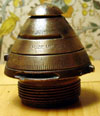3-inch Scoville Mk XI Fuze (original) (raw)
3-inch Scoville Fuze
The following appeared on MARHST-L in November, 2000, and is reproduced here by permission.
[](usn3fz1l.jpg) [
[](usn3fz2l.jpg)
Photos courtesy and copyright Patrick B. Smith, CMAR (Patrick@seafore.com)
[![[Drawing]](http://www.gwpda.org/naval/usn3fz0s.gif) ](usn3fz0l.gif)
](usn3fz0l.gif)
Drawing courtesy of Ed Rudnicki
(Click on each illustration for an enlargement)
Edward Rudnicki (erudnick@PICA.ARMY.MIL)
"An acquaintance plays with a "FUZE MK-XI 3 SCOVILLE" that was recovered from a 3" shell at the site of the 1923 US Navy Honda Disaster (underwater for 75 years). Are there any explosives associated with this device? It is a cone-shaped brass device with threaded base, approx. 60mm in width by 70mm in height. There appear to be two adjustable rings at the widest point - one scribed with a "0" and a line, and the other with a scale marked from "0" to "21" Could someone explain the settings?"
Your acquaintance has an example of a naval version of the Scoville 21 Second Combination Time and Percussion Fuze. Scoville made around 20 million of these during the Great War, used by the US, UK, and Russia. The primary use was with shrapnel shells, but there was an antiaircraft version, presumably for use with bursting shells. I suspect this one is of the latter type, as shrapnel is not typically used by naval vessels.
The fuze contains a percussion element as a backup to its primary time mode of operation. The timing element is of the pyrotechnic/powder train type. The 21 is the maximum time setting, in seconds; this was a typical maximum time setting in that time period. Setting it at "0" would cause the fuze to function immediately upon muzzle exit, allowing shrapnel to be used for close-in defense of the gun against personnel.
As to hazards, well, I can't be definite without seeing it. But the base of the fuze should be flat, with two holes for a spanner wrench, and a central hole. That central hole should not have a small cylinder threaded into it. If it does, it's a booster, and a Very Bad Thing. Otherwise, most of the energetic material in the fuze is black powder of various formulations and grain sizes, which would _likely_ (but not necessarily certainly) have been neutralized by seawater immersion.
...I'd still advise against keeping it. The detonator may not have been degraded by seawater. In addition, BP being hygroscopic, most of the energetic elements would have been sealed with various lacquers and varnishes; some of those seals may have survived. And unless all of the potassium nitrate has been leached out by the seawater, the BP becomes hazardous again once it dries.
William Schleihauf
I would imagine that the USN of the era was operating along similar lines to the RN, thus the following set of suppositions. The use of a time fuze was almost certainly for anti-aircraft use: some form of "predictor" would come up with some estimate of fuze delay, which would be set on the fuze before being loaded into the gun, and fired ASAP. If the calculations and guesses were right, and St. Barbara was favourable, the shell would burst in the vicinity of the aircraft. For AA use, they would not be set to 'percussion', although the fuze *might* (I simply don't know) have been designed to burst on contact as well as after the set delay. I think that at the time, AA shells + shrapnel were basically the same thing.
Edward Rudnicki (erudnick@PICA.ARMY.MIL)
The percussion element was a backup to the time element, should the projectile hit something prior to the time expiring. I don't know if the fuze had a true percussion-only setting, but given that its primary use was in shrapnel, this is unlikely.
Note that AA shells, during World War One, did use shrapnel after all.
Nathan Okun, January 2001 (OkunNF@phdnswc.navy.mil)
I looked at that 3" Powder Time Fuze. The upper ring has the powder train pass through it and then to the lower ring. As the upper ring merely has a single line on it, it probably is designed to allow it to be adjusted slightly during assembly at the manufacturing plant to null out any tolerance errors. The lower ring has an "S" for SAFE as well as a "0" time setting (muzzle action, I assume. Note that there is a gap between the "0" and the minimum time setting, since the use of black powder would mean a minimum time no matter how short the tunnel used if the powder had to burn in the adjustable ring tunnel--the "0" setting bypassed the lower rotating time setting ring tunnel altogether, I assume.
The projectile used an asymmetric pivoted weight in the lower center of the fuze to allow arming by spinning, as the spring-loaded block cutting the powder train could not move until the weight had rotated under the centrifugal forces on the projectile as it spun up due to the gun's rifling during acceleration in the gun barrel to swing its flat side in the block's direction, finally allowing the block to move and unblock the powder train. This pivoted weight concept was also used by the U.S. Army post-WWI "Semple" base fuze for large-caliber AP projectiles (including those for Coast Defense guns), where the pivoting weight had the firing pin sticking out of its top like a finger and it was only aligned with the primer container (held away from the finger by a spring prior to impact) after the spin-up of the projectile; otherwise, it was held in a tilted direction (unusable) until a pin withdrew on firing the gun (setback forces) that now allowed the weight to rotate to the armed position. The U.S. Navy did not consider such fuzes safe enough after WWI, though I think some WWI-era U.S. Navy fuzes used similar mechanisms to this Semple fuze design.
Last Updated: 30 September, 2001.
Return to WWI The Maritime War
Return to WWI Archive main page.